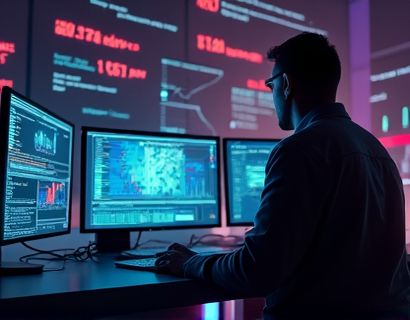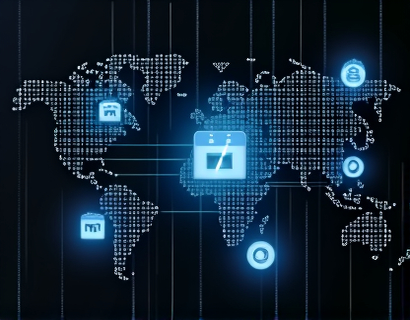Blockchain-Powered Asset Tokenization: Bridging Physical Assets with Digital Liquidity
In the evolving landscape of finance and asset management, the integration of blockchain technology has emerged as a transformative force. One of the most promising applications of blockchain is asset tokenization, a process that bridges the gap between physical assets and the digital world. This innovative approach not only enhances liquidity and market accessibility but also revolutionizes the way assets are managed and traded. By leveraging the immutable and transparent nature of blockchain, asset tokenization offers a secure and efficient solution for asset holders and investors alike.
Understanding Asset Tokenization
Asset tokenization involves converting real-world assets into digital tokens on a blockchain network. These tokens represent a fraction or the entirety of the underlying asset, such as real estate, art, machinery, or even intangible assets like intellectual property. The process begins with the identification and valuation of the asset, followed by the creation of a smart contract that defines the rules and parameters of the token. These tokens can then be bought, sold, or traded on blockchain-based platforms, providing unprecedented liquidity to assets that were previously illiquid or difficult to trade.
Enhancing Liquidity
One of the primary benefits of asset tokenization is the significant enhancement of liquidity. Traditional assets often face challenges in terms of liquidity due to their illiquid nature and the lack of a broad investor base. Tokenization changes this dynamic by allowing assets to be divided into smaller, tradable units, making them accessible to a wider range of investors. This increased participation leads to higher trading volumes and more competitive pricing, ultimately benefiting both asset holders and investors.
For instance, a commercial real estate property that would traditionally require a substantial investment to purchase can be tokenized into thousands or even millions of smaller tokens. This allows individual investors to buy into the property with a much lower entry point, thereby increasing the overall liquidity of the asset. The ability to buy and sell these tokens on blockchain platforms ensures that there is always a market for the asset, reducing the risk of holding a non-liquid asset.
Improving Market Accessibility
Asset tokenization also democratizes access to investment opportunities. Traditionally, high net worth individuals and institutional investors dominated the market for real assets. Tokenization lowers the barriers to entry, enabling retail investors to participate in investments that were once out of reach. This democratization not only broadens the investor base but also fosters a more inclusive financial ecosystem.
Moreover, the global nature of blockchain networks means that asset tokens can be traded across borders without the need for intermediaries such as banks or brokers. This reduces transaction costs and speeds up the trading process, making it more efficient and accessible for investors worldwide. The transparency provided by blockchain technology further enhances trust and confidence in the market, as all transactions are recorded and verifiable.
Security and Transparency
The security and transparency offered by blockchain are fundamental to the success of asset tokenization. Blockchain's decentralized and immutable ledger ensures that once a transaction is recorded, it cannot be altered or deleted. This immutability provides a high level of security against fraud and manipulation, which are common concerns in traditional asset markets.
Transparency is another key advantage. All transactions on a blockchain are visible to all participants, providing a clear and auditable trail. This level of transparency reduces the risk of disputes and increases trust among market participants. For asset holders, this means greater assurance that their assets are managed and traded fairly and securely.
Use Cases and Applications
The applications of asset tokenization are vast and varied, spanning multiple industries. Here are some notable use cases:
- Real Estate: Tokenization of real estate assets allows for fractional ownership, making it possible for multiple investors to own a share of a property. This can increase the liquidity of real estate investments and provide a new revenue stream for property owners.
- Art and Collectibles: High-value art pieces and collectibles can be tokenized, enabling artists and collectors to monetize their assets more easily. This also opens up new markets for art investors who can now own fractions of valuable pieces.
- Infrastructure and Equipment: Tokenization of infrastructure projects and heavy machinery can improve funding and maintenance through decentralized investment and management. This can lead to more efficient and transparent operations in sectors like transportation and energy.
- Intellectual Property: Creators can tokenize their intellectual property rights, such as patents and copyrights, to monetize their work more effectively and manage usage rights more efficiently.
These use cases demonstrate the versatility and potential impact of asset tokenization across various sectors. By providing a secure and transparent platform for asset management, blockchain-driven tokenization opens up new opportunities for asset holders and investors.
Challenges and Considerations
Despite its numerous benefits, asset tokenization is not without challenges. One of the primary concerns is regulatory compliance. The legal framework surrounding digital assets and blockchain technology is still evolving, and different jurisdictions have varying regulations. Asset tokenizers must navigate these complexities to ensure compliance and avoid legal issues.
Another challenge is the technical complexity of blockchain and smart contracts. While the technology is powerful, it requires a certain level of expertise to implement effectively. This can be a barrier for asset holders and investors who may not have the necessary technical knowledge. Education and user-friendly platforms are essential to overcome this hurdle.
Scalability is also a critical consideration. As the number of tokenized assets grows, blockchain networks must be able to handle the increased load without compromising performance. Solutions like layer 2 protocols and cross-chain interoperability are being developed to address these scalability issues.
Future Prospects
The future of asset tokenization looks promising, with ongoing advancements in blockchain technology addressing current challenges. The development of more efficient consensus mechanisms, improved scalability solutions, and clearer regulatory guidelines will further enhance the viability and adoption of asset tokenization.
As more institutions and industries recognize the potential of blockchain-driven asset management, we can expect to see increased collaboration and innovation. This will lead to more robust and user-friendly platforms, expanding the reach and impact of asset tokenization.
In conclusion, asset tokenization represents a significant leap forward in the way we manage and trade physical assets. By leveraging the power of blockchain, this innovative approach enhances liquidity, improves market accessibility, and ensures security and transparency. As the technology matures and regulatory frameworks evolve, asset tokenization is poised to transform the financial landscape, offering new opportunities for asset holders and investors alike.










































